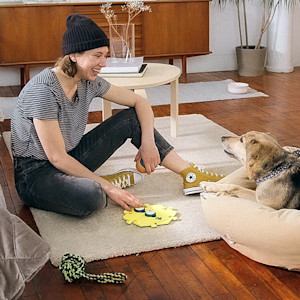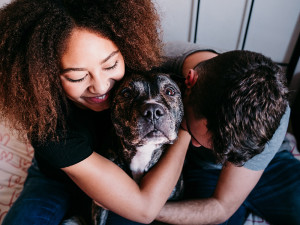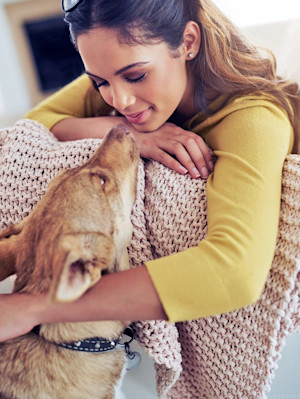Can Your Dog Tell When You’re Lying?
They can sniff out where you’ve hidden their treats, but deception is another matter.

Share Article
Dogs are synonymous with loyalty. Most would follow their parents to the ends of the earth. Mine obsessively follows me to the bathroom. But as loyal as they are, surely, sometimes, they’re skeptical of us, right? Or raise their eyebrows when we say they will get a treat if they come to us at the park but in fact we are fresh out? Are they little detectives who can suss out when we’re lying?
They certainly seem to be able to read human emotion. A study publishedopens in new tab earlier this year in Animal Behaviour suggests dogs may have evolved to understand human emotion. Researchers found that dogs showed more signs of stress (i.e., shaking, whining) when they heard the sound of a human crying than when they heard the sound of a person humming. They believe years of domestication may have conditioned dogs to match the emotional state of their human companion.

Save on the litter with color-changing tech that helps you better care for your cat.
A 2017 studyopens in new tab on how dogs respond to different human expressions found similar results: Looking at a human with an angry face triggered dogs to lick their mouths, a behavior associated with excitation and stress. Given their ability to sense negative emotional states, can dogs also sniff out a liar?
Researchers used the Sally-Anne test for dogs.
The short answer is yes, dogs can pick up on whether they have been given false information.
In 2021, researchers from the University of Vienna studied whether dogs could distinguish between honest and deceptive peopleopens in new tab. They used a variation of the Sally-Anne testopens in new tab, a psychological assessment evaluating social cognition and the ability to understand other people’s beliefs and perceptions. In the original experiment, researchers pose the below problem to children:
Sally hides a marble in a basket and leaves the room. While Sally is gone, Anne moves the marble from Sally’s basket and hides it in a box. When Sally comes back, where will she look for her marble?
Children under five, as well as some apesopens in new tab, often indicate that Sally would look for her marble in the basket where she originally hid it. Experts believe this shows an ability to anticipate the behavior of someone with a false belief. Although researchers from the University of Vienna anticipated dogs to behave similarly to apes or children under five, the results were a little different.
For their experiment, researchers trained 260 dogs to find hidden food in one of two covered bowls. A person, whom the dog hadn’t met, would touch the bowl with food and verbally indicate that there was food in that dish. After establishing trust with the new person, the dog reliably following their correct signaling, a new person was introduced.
With the dog present, the second person would move the food from one bowl to the other. In some instances, the first person was present and witnessed the switch; in others, the first person left the room, apparently unaware that the food moved. In both instances, the first person would indicate to the dog that the food was still in the now-empty dish.
If the first person left the room while the switch happened, half of the dogs would follow their incorrect advice and go to the now-empty bowl. However, if the first person witnessed the food being switched, about two-thirds of dogs ignored the person’s suggestion when they gestured to the now-empty bowl, going instead to the opposite bowl with food. In other words, they could sense when the person was not completely trustworthy.
A studyopens in new tab conducted in 2014 found similar results: Dogs appear to make inferences about a person’s reliability, modifying future behavior depending on whether that person tells them correct or incorrect information.
So, does that mean my dog knows when I sneak medicine into some cheese or trick them into going to the vet?
The short answer: probably not. As Becky Mathia, a certified dog trainer and adoptions manager with Kansas City shelter Wayside Waifsopens in new tab, tells us, our dogs are often responding to our body language and tone of voice. However, they do learn from repetition. “If we consistently ‘fake them out’ or ‘lie to them’ they can pick up on that pattern, or get to the point where they are confused and not wanting to listen to us,” Mathia says.
Brett Currie, Wayside Waifs Canine Public Training and Behavior Manager, also emphasized dogs’ ability to pick up on repeated cues. “Dogs do not have the capacity to think ‘I think they’re lying to me or tricking me,’ but they do pick up on patterns very quickly,” Currie tells us, noting that dogs are also using their own senses and experiences when decision making. “Dogs have an incredible sense of smell,” she adds. “So, if they’ve associated the smell of a pill with something that tastes badly, it’s going to be difficult to get them to take it again.”
If your dog is hesitant to, say, eat a pill hidden inside a piece of turkey, that may have more to do with their ability to smell something they don’t like than their expertise in lie detection.
Can dogs lie?
When it works to their advantage, they sure do.
In 2017, Animal Cognitionopens in new tab published a study on deceptive behavior in dogs. Results showed that dogs appeared to adjust their behavior, depending on whether they were working with a “cooperative” human partner or a “competitive” human partner. The dogs showed an ability to use tactical deception, leading a cooperative partner toward a food reward and a competitive partner away from it. In other words, dogs appeared to “lie” when it was in their best interest.
“Dogs learn best when we are consistent with our training,” Mathia reminds us. “But we can do things to make the training fun and keep the dog interested!” If you’re worried about establishing trust with your pup, she suggests balancing tough training with multiple forms of positive reinforcement, like treats, walks, and playing outside.

Mia Mercado
Mia Mercado is a writer whose work has appeared in The New Yorker, New York, the New York Times, Cosmopolitan, Bustle, and more. She’s also the author of two essay collections, Weird But Normal (2020) and She's Nice Though (2022), both published by HarperOne.
Related articles
![Woman hugging her dog outside.]()
Your Dog Can Understand Your Facial Expressions, Study Says
And they love it when you smile.
![Woman teaching her dog how to use speech buttons.]()
Dogs Really Do Understand Speech Buttons, New Study Finds
Those viral Tiktok videos may not be all smoke and mirrors.
Do Dogs and Cats Care What They Look Like?
They do seem to act different after a trip to the groomer, right?
![Couple hugs their merle Boxer]()
How to Improve Your Relationship with Your Dog
Animal behaviorist Dr. Karen B. London on how to strengthen your pet-parent bond.
![Brunette girl with tattoo on shoulder hugs dog.]()
Do Dogs Get Grumpy? Yes, So Here’s How to Cheer Them Up
Canine grumpiness is very real and the summer heat doesn't help.
![Dog comforting a woman at home.]()
Thanks to Evolution, Your Dog Understands Your Emotions
Per a new study, pups show signs of stress when humans cry—but not all animals do.








